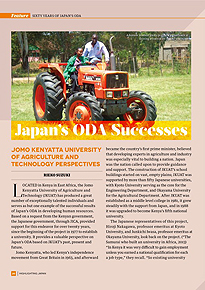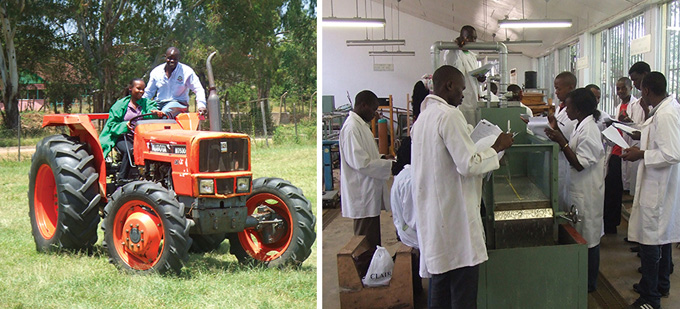Home > Highlighting JAPAN >Highlighting Japan August 2014>Sixty Years of Japan's ODA
Highlighting JAPAN

Sixty Years of Japan's ODA
Japan’s ODA Successes
Jomo Kenyatta University of Agriculture and Technology Perspectives

Located in Kenya in East Africa, the Jomo Kenyatta University of Agriculture and Technology (JKUAT) has produced a great number of exceptionally talented individuals and serves as but one example of the successful results
of Japan’s ODA in developing human resources. Based on a request from the Kenyan government, the Japanese government, through JICA, provided support for this endeavor for over twenty years, since the beginning of the project in 1977 to establish a university. It provides a valuable perspective on Japan’s ODA based on JKUAT’s past, present and future.
Jomo Kenyatta, who led Kenya’s independence movement from Great Britain in 1963, and afterward became the country’s first prime minister, believed that developing experts in agriculture and industry was especially vital to building a nation. Japan was the nation called upon to provide guidance and support. The construction of JKUAT’s school buildings started on vast, empty plains; JKUAT was supported by more than fifty Japanese universities, with Kyoto University serving as the core for the Engineering Department, and Okayama University for the Agricultural Department. After JKUAT was established as a middle level college in 1981, it grew steadily with the support from Japan, and in 1988 it was upgraded to become Kenya’s fifth national university.
The Japanese representatives of this project, Hiroji Nakagawa, professor emeritus at Kyoto University, and Junkichi Iwasa, professor emeritus at Okayama University, look back on the project. (“The Samurai who built an university in Africa, 2013) “In Kenya it was very difficult to gain employment unless you earned a national qualification for each a job type,” they recall. “So existing university curriculums—as well as the students themselves—were biased toward memorizing information that would help them pass the national qualification exams. However, several years after we introduced the Japanese university educational principles of focusing on experiment and practice based on thorough comprehension of basic subjects, there was a dramatic rise in the rate of successful national qualification exam results.”
Japan’s assistance was provisionally completed in 2000, as it was considered that JKUAT could undertake all university operations themselves. Even without ODA, however, as many as 202 Japanese involved with JKUAT continue to support JKUAT students through the Babaroa Scholarship, which provides scholarships to students who achieve the highest distinction. Over the span of fifteen years, a total of 583 students have been awarded this scholarship. While the student body numbered only 717 in 2001, by 2012 it had increased to 30,788 students, and graduates are now flourishing in a diverse range of fields, including ICT, architecture, horticulture and foods, and NPOs. Furthermore, a large number of graduates have also taken teaching positions at JKUAT and its four affiliated national universities.
For Japanese firms hoping to make inroads into Kenya and the surrounding regions, JKUAT is a valuable presence. For example, Nissin Foods—a Japanese processed foods manufacturer—established a joint enterprise with the university and began developing instant noodles by incorporating feedback from students and the local population. Having industry and university join forces makes practical research possible, and being able to initiate business ventures with a university that has had Japanese involvement since day one provides low-risk investment opportunity for Japanese firms. Only JKUAT, with its Japanese backing, can provide such a win-win environment.
Recently, JKUAT is taking the next step toward becoming a university that contributes to the whole African continent, based on the concept of the Pan-African University (PAU), which is supported by the African Union. In June 2013 at the Tokyo International Conference on African Development, it was officially decided that Japan would again provide ODA support. PAU was established based on the concept of developing and securing the human resources who will lead Africa’s economic and social future, in response to the severe problem of brain drain of African countries. PAU divides the African continent into five regions, and each region designates the countries and universities that take leading roles and selects the overseas donor countries that provide support, focusing efforts into research and education in specialized fields. In the East African region, Kenya’s JKUAT was chosen at the host university in the field of basic science, technology and innovation. Japan decided to support JKUAT with its focus on promoting African innovation.
JKUAT, which symbolizes the strong bond between Kenya and Japan through Japan’s ODA, is expected to grow even stronger, with its energetic development producing innovative and creative talent, spreading its impact to affiliated universities and businesses.
© 2009 Cabinet Office, Government of Japan






